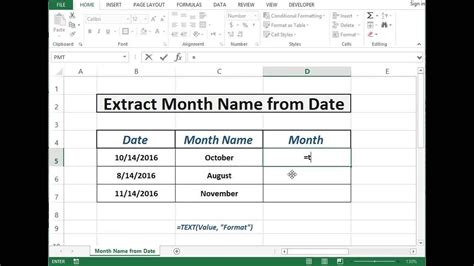5 Ways Extract Month

Extracting Months from Dates: A Comprehensive Guide

When working with dates in various programming languages or data analysis tools, extracting the month from a date string is a common requirement. This can be necessary for filtering data by month, creating monthly reports, or performing seasonality analysis. In this article, we will explore five different methods to extract the month from a date, covering a range of scenarios and tools.
Method 1: Using Excel Formulas

In Microsoft Excel, you can easily extract the month from a date using the MONTH function. This function takes a date as input and returns the month as a number (1-12). Here’s how you can use it: - Assume you have a date in cell A1. - Use the formula:
=MONTH(A1)
- This will return the month of the date in A1.
For example, if A1 contains the date 2023-04-15, the formula =MONTH(A1) will return 4, which represents April.
Method 2: Using Python

Python is a versatile programming language that offers several ways to manipulate dates, including extracting the month. You can use the datetime module for this purpose. Here’s an example:
from datetime import datetime
# Define a date string
date_string = "2023-04-15"
# Parse the date string into a datetime object
date_object = datetime.strptime(date_string, "%Y-%m-%d")
# Extract the month
month = date_object.month
print(month) # Output: 4
This Python code snippet demonstrates how to parse a date string into a datetime object and then extract the month from it.
Method 3: Using SQL

In SQL, the method to extract the month from a date depends on the specific database management system you are using. Here are examples for MySQL, PostgreSQL, and SQL Server: - MySQL: Use the MONTH function, e.g.,
SELECT MONTH('2023-04-15');
- PostgreSQL: Use the EXTRACT function, e.g., SELECT EXTRACT(MONTH FROM '2023-04-15');
- SQL Server: Use the MONTH function, e.g., SELECT MONTH('2023-04-15');
These SQL functions extract the month from a specified date.
Method 4: Using JavaScript

In JavaScript, you can extract the month from a date using the getMonth method of the Date object. Note that this method returns the month as a zero-based value (0-11), where 0 represents January and 11 represents December. Here’s an example:
let date = new Date('2023-04-15');
let month = date.getMonth() + 1; // Add 1 to make it 1-12
console.log(month); // Output: 4
This JavaScript code creates a new Date object from a date string, extracts the month using getMonth, and then adjusts the value to match the 1-12 range.
Method 5: Using R

In R, a popular language for statistical computing and graphics, you can extract the month from a date using the format function or by converting the date to a POSIXlt object and then accessing the $mon component. Here’s how to do it:
date <- as.Date("2023-04-15")
month <- format(date, "%m") # %m gives the month as a decimal number (01-12)
# Alternatively
date_posixlt <- as.POSIXlt(date)
month_from_posixlt <- date_posixlt$mon + 1 # $mon is 0-11, so add 1
print(month) # Output: "04"
print(month_from_posixlt) # Output: 4
This R code snippet shows two ways to extract the month from a date: using the format function with the ”%m” format specifier and by converting the date to a POSIXlt object and accessing its $mon component.
📝 Note: When working with dates and months, consider the context and the specific requirements of your project, including the format of the input dates and the desired output format.
As we’ve explored these five methods for extracting months from dates across different tools and programming languages, it’s clear that each has its own approach, reflecting the unique features and conventions of each environment. Whether you’re working in Excel, Python, SQL, JavaScript, or R, understanding how to manipulate dates effectively is crucial for data analysis and processing tasks.
To summarize, extracting the month from a date is a fundamental operation that can be accomplished in various ways depending on the tool or programming language you are using. From the MONTH function in Excel and SQL to the datetime module in Python, the getMonth method in JavaScript, and the format or POSIXlt approaches in R, each method has its specific syntax and application. By mastering these techniques, you can more efficiently work with dates in your projects, whether for data analysis, reporting, or other purposes.



